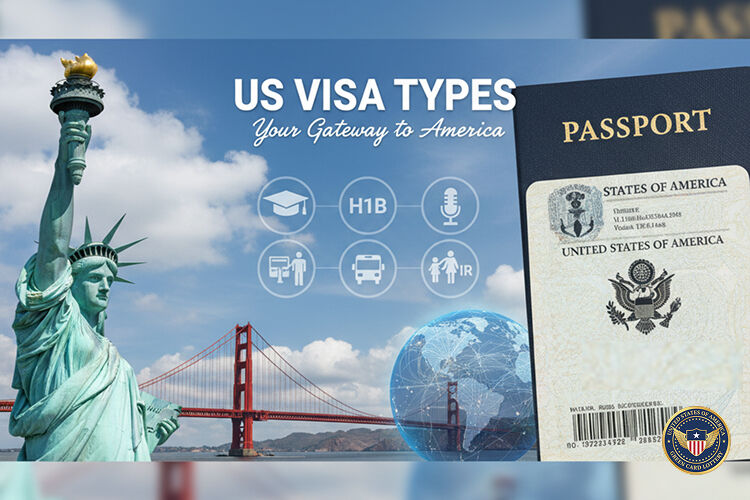
Complete Guide to US Visa Types: Temporary and Immigrant Visas Explained
The United States offers one of the most comprehensive and structured visa systems in the world. Whether you want to visit for tourism, study at a US university, work in a specialized occupation, or live permanently with your family, there’s a specific visa category for every purpose.
US visas are broadly divided into two major categories:
- Nonimmigrant Visas – For temporary visits, such as travel, business, study, or short-term work.
- Immigrant Visas – For those planning to live permanently in the United States.
Understanding which visa applies to your situation is the first and most crucial step before beginning the application process. Let’s explore each category in depth.
Table of Contents
1. Nonimmigrant (Temporary) Visas
Overview Table of Major Visa Types
What Are Nonimmigrant Visas?
Nonimmigrant visas are designed for foreign nationals who wish to enter the United States for a temporary purpose. This may include travel, business, education, training, medical care, or short-term work. Holders of these visas must demonstrate an intent to return to their home country upon expiration of their authorized stay.
Nonimmigrant visas generally have limited validity periods and specific restrictions on work or study. There are more than 30 types of nonimmigrant visas, each serving a different purpose.
A. Visitor Visas (B-1 and B-2)
These are among the most common types of US visas.
- B-1 Visa (Business Visitor):
- For individuals entering the US temporarily for business meetings, conferences, contract negotiations, or consultations. It does not allow employment.
- B-2 Visa (Tourism/Medical):
- For tourists, family visits, recreational activities, or medical treatment.
These visas can sometimes be combined into a B-1 B-2 visa, valid for multiple entries over several years.
Duration of Stay: Typically 6 months, with some cases extending to 12 months.
Important Note: Applicants must demonstrate their financial ability to support their stay and have strong ties to their home country.

B. Student and Exchange Visitor Visas (F, M, and J)
Education-related visas allow foreigners to study, train, or participate in exchange programs in the US
- F-1 Visa (Academic Students):
- For full-time students enrolled at accredited US institutions. Holders can work part-time on campus and apply for Optional Practical Training (OPT) after graduation.
- F-2 Visa: Dependents (spouse and children) of F-1 holders.
- M-1 Visa (Vocational Students):
- For non-academic programs such as technical or trade schools.
- J-1 Visa (Exchange Visitors):
- For exchange scholars, professors, interns, or trainees participating in approved cultural exchange programs.
- J-2 Visa: Dependents of J-1 visa holders.
Special Requirement:
Some J-1 participants are required to return to their home country for at least two years before applying for certain US visas or permanent residence.

C. Temporary Worker Visas
The US offers a wide range of work visas to attract skilled professionals, seasonal laborers, and specialized talent.
H Visa Categories
- H-1B: For professionals in specialty occupations (IT, engineering, medicine, etc.) requiring a bachelor’s degree or higher.
- H-2A: For temporary agricultural workers.
- H-2B: For temporary non-agricultural workers (hospitality, construction, etc.).
- H-3: For trainees who wish to gain training in fields not available in their home country.
L-1 Visa (Intra-company Transfer)
For employees of multinational companies transferring from a foreign office to a US branch.
- L-1A: Managers and executives.
- L-1B: Specialized knowledge employees.
O and P Visa Categories
- O-1: For individuals with extraordinary ability or achievement in fields like science, art, education, or athletics.
- O-2: Support personnel accompanying O-1 visa holders.
- P-1/P-2/ P-1/P-2/P-3: For athletes, artists, entertainers, and their support teams participating in specific events.
E Visa Categories
- E-1: Treaty traders engaged in substantial international trade with the US
- E-2: Treaty investors investing a significant amount of capital in a US business.
- E-3: For Australian professionals in specialty occupations.
TN/TD Visa
For professionals from Canada or Mexico under the United States-Mexico-Canada Agreement (USMCA).
D. Diplomatic and Official Visas
- A Visa: For diplomats, foreign government officials, and their staff.
- G Visa: For representatives and employees of international organizations, including the United Nations and the World Bank.
These visa holders enjoy special privileges under international law.
E. Other Specialized Nonimmigrant Visas
- C Visa: Transit through the United States to another destination.
- D Visa: For crew members of airlines or ships.
- Q-1 Visa: For participants in cultural exchange programs.
- R-1 Visa: For religious workers and ministers of religion.
- T Visa: For victims of human trafficking.
- U Visa: For victims of certain crimes who assist law enforcement.
Each of these categories has distinct eligibility rules and documentation requirements.

2. Immigrant (Permanent) Visas
What Are Immigrant Visas?
Immigrant visas allow foreign nationals to live permanently in the United States. Once an immigrant visa holder enters the country, they become a lawful permanent resident (also known as a Green Card holder). They can later apply for US citizenship after meeting specific requirements.
Immigrant visas are typically sponsored by a family member, employer, or the US government through programs such as the Diversity Visa Lottery.
A. Family-Based Immigration
Family reunification remains one of the most common paths to US immigration.
- Immediate Relative Category (Unlimited):
- Spouses of US citizens.
- Unmarried children under 21 of US citizens.
- Parents of US citizens (aged 21 or older).
- Family Preference Categories (Subject to Annual Caps):
- F1: Unmarried adult children of US citizens.
- F2A/F2B: Spouses and children of lawful permanent residents.
- F3: Married sons and daughters of US citizens.
- F4: Siblings of US citizens.
B. Employment-Based Immigration (EB-1 to EB-5)
Employment-based visas are designed for professionals, skilled workers, and investors.
- EB-1: Individuals with extraordinary abilities, multinational executives, and outstanding professors.
- EB-2: Professionals with advanced degrees or exceptional ability in sciences, arts, or business.
- EB-3: Skilled workers, professionals, and other laborers.
- EB-4: Special immigrants, such as religious workers or certain translators.
- EB-5: Immigrant investors who invest between $800,000 and $1.05 million in a qualifying US business that creates jobs.

C. Diversity Visa Lottery (DV Program)
The Diversity Visa (DV) Lottery, also known as the Green Card Lottery, grants 50,000 immigrant visas annually to applicants from countries with low rates of immigration to the US.
While the application is free, it’s easy to make mistakes that lead to disqualification, such as incorrect photos or incomplete details. This is why many applicants choose to use professional services like the US Green Card Office, which assists with photo verification, form submission, and eligibility review.
Applicants must meet educational or work experience requirements and be born in an eligible country.
Key Points:
- Registration typically opens in October each year.
- Results are announced in May of the following year.
- Individuals who are selected can apply for permanent residency through a US embassy or consulate.
D. Special Immigrant and Returning Resident Visas
- Extraordinary Immigrant (SI): Religious workers, certain US government employees, and translators.
- Returning Resident (SB-1): Lawful permanent residents returning to the US after extended stays abroad.
3. Choosing the Right Visa
Selecting the correct visa depends on your travel purpose, duration of stay, and long-term plans.
- For short visits → Nonimmigrant visas like B-1/B-2.
- For educational purposes, F, M, or J visas are available.
- For temporary employment → H, L, O, or P visas.
- For permanent residence → Family, Employment, or Diversity Visa Lottery.
Always ensure your visa intent aligns with your declared purpose. Misrepresentation can lead to permanent bans.
4. Common Mistakes to Avoid
- Applying for the wrong visa category.
- Overstaying your visa validity period.
- Providing incomplete or inaccurate documentation.
- Assuming a visa guarantees entry. (Final decision lies with US Customs and Border Protection.)
- Failing to maintain nonimmigrant status conditions.
Proper preparation and understanding of visa rules can save time, money, and potential disqualification.
5. Conclusion
Understanding US Visa types or US visa categories is vital to achieving your immigration, travel, or study goals. Whether you’re visiting temporarily or pursuing permanent residence, selecting the correct visa ensures compliance with US immigration laws and facilitates a smooth processing.
Each visa type serves a unique purpose, from the B-1 business visitor to the EB-5 investor immigrant. Always prepare complete documentation, stay informed about eligibility updates, and consider professional help if your case is complex.
Your journey to the United States begins with the correct visa and proper preparation.


